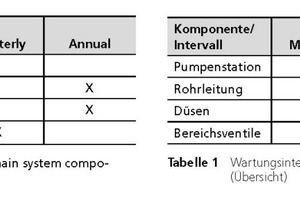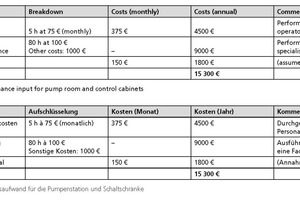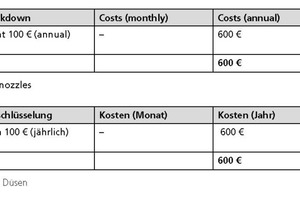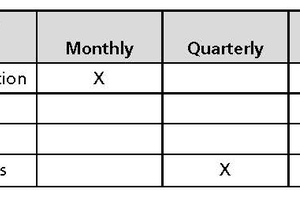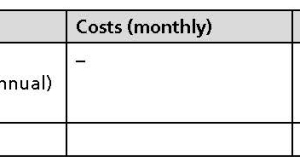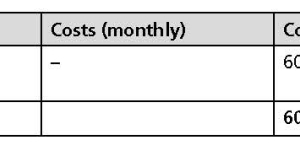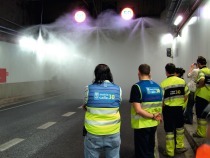Servicing and Maintenance of Water-Mist Fire-Fighting Systems in Road Tunnels
Operators are deciding ever more frequently to equip their tunnels with a water-mist fire-fighting system (water-mist FFS). Here, water-mist FFS should not be regarded as “add-ons”, but should, instead, be integrated into the overall safety concept from the very start of the project. Regular servicing and maintenance is necessary to assure the availability of the FFS. This, of course, also applies to many facilities in the tunnel, such as the lighting, ventilation and event detection systems, for example. Recently, and particularly in Germany, the question has arisen of what costs will be incurred from installing fire-fighting systems.
Water mist as a fire-fighting technology has been standard equipment in very many sectors for many years now, for the protection of industrial facilities, buildings, trains and cruise ships, for example. Water-mist FFS are also increasingly being installed in tunnels (Fig. 1). The following provides an overview of the scope and costs of the servicing and maintenance of FFS. Experience gained from installations completed in the past is taken as the basis for evaluation. Codes and standards are also examined, where they are applicable to FFS in tunnels.
1 Water-Mist FFS in Tunnels – System Structure
The general structure of a water-mist FFS is described here by way of example, in order to permit better discussion of the requirements for servicing and maintenance. An FFS consists essentially of a pumping station, a piping system, nozzles and section valves. It is, therefore, a relatively uncomplicated apparatus. Fig. 2 shows a rough overview of the structure of a water-mist FFS in a tunnel.
Pumping Station
The pumping station is located easily accessible outside of the tunnel. The station comprises high-pressure pumps, complete with control cabinets, pressure-booster pumps, a pressure-maintenance pump, filter units, along with piping and valves/fittings. A water tank (usually located outside the pumping station) supplies the FFS with the necessary flow of water. A main pipe filled with water (“the main”) runs from the pump house through the tunnel, connecting the pumping station to the section valves.
Piping System
The water-filled main is fixed to the tunnel roof or is located in a service tunnel. It should, to comply with the relevant standards and codes, consist of high-quality stainless steel. Pipe connections are mainly made by means of welding. In zones potentially exposed to frost, the main is equipped with a pipe trace-heating system, and also with insulation and a protective sheathing. Alternatively, antifreeze agents can be added to the water. The section pipes also consist of stainless steel. The nozzles which generate the water mist when the system is activated are mounted on these section pipes.
Water-Mist Nozzles
Small brackets, into which special nozzles are screwed, are welded to the section pipes. These nozzles consist of a number of micro-nozzles which atomise the water mist. As is customary in fire-protection systems and, in particular, against the background of the aggressive ambient conditions found in tunnels, these nozzles must not have any moving components.
Section Valves
The section valves isolate the water-filled main from the section pipes. When the system is activated, the corresponding section valves are opened by means of a servo-motor, which itself is activated by a signal from the control system. In many cases, the section valves are located beneath the tunnel roof, in order to protect them against mechanical damage caused by vehicles. The valves are installed in a fireproof enclosure. The section valve is the only active component located in the tunnel, and special importance therefore attaches to this valve in servicing and maintenance of the FFS.
Control of the FFS
The FFS is integrated into the overall tunnel control system. This includes the pumping station; the pumps are started by a signal from the control system. The section valves are also integrated into the control system. Maintenance of the control system will be ignored in the rest of this article, since this subject does not include any special features compared to other control systems in the tunnel.
2 Maintenance of a Water-Mist FFS – Scope and Costs
The scope and costs of servicing and maintaining water-mist FFS in tunnels may vary according to the manufacturer, the structure of the system and local circumstances. In Germany, materials requirements in accordance with RABT (Rules for the Equipping and Operation of Road Tunnels) and/or ZTV-ING (Supplementary Technical Contractual Conditions for Engineering Projects) must be fulfilled. In many cases, the rules of the SOLIT guideline apply. This guideline defines the minimum requirements for the structure of a water-mist FFS.
The scope and/or costs of maintenance also depend indirectly on the requirements made on the availability of a particular system. It is thus possible, for example, that high-availability systems make greater demands on maintenance; this must not necessarily be the case, however. The availability of water-mist FFS is, in general, very high. For this reason, such systems are frequently used as the primary fire-protection for cruise ships, hospitals and even nuclear power plants, for example. The authors have in the past been involved in projects for which significantly higher requirements were specified, such as the defined Safety Integrity Level (“SIL“), for instance. The following rule should, however, apply at all times: Good planning and design, combined with good execution, will permit lower maintenance costs.
The following section is intended to provide an overview of the current status of relevant codes/standards concerning the servicing/maintenance of FFS, followed by an estimation of maintenance expenses and costs for the main system components.
2.1 Maintenance in Accordance with Codes and Standards
Various codes and other documents describing the suggested scopes of maintenance on FFS in tunnels have been published in recent years.
SOLIT2 Guidelines for the Holistic Evaluation of Tunnels Featuring Fire-Fighting Systems and their Planning – Annex 3 [1]
This is internationally the most frequently applied code and provides a comprehensive overview of the use of FFS in tunnels. Annex 3 of the guideline describes technical requirements for FFS in tunnels. The publication also includes a section on the servicing/maintenance of essential system components. These stipulations are to be understood as minimum requirements; more extensive scopes or servicing/maintenance must be defined in individual cases.
PIARC – “Fixed Fire-Fighting Systems in Road Tunnels: Current Practices and Recommendations” [2]
This 2016 publication by the World Road Association describes the use of FFS in tunnels on the basis of experience gained in recent years. The document provides an overview of various system types, the results of real fire tests and the integration of FFS into the overall safety concept for a tunnel. The publication also provides recommendations for maintenance intervals.
UPTUN – “Technical Guideline for Water-Based Fire-Fighting System for Tunnels” [3]
This guideline, available only in English, was drafted as the result of the European “UPTUN” (“Upgrading of Existing Tunnels”) research project. It, too, can also be found in many tendering specifications internationally and defines minimum requirements on FFS for tunnels. Servicing/maintenance is examined in a, regrettably, short section.
Further Codes and Documents
There are, in addition, also numerous national and international codes of practice dealing with the installation, operation and servicing/maintenance of FFS in various fields of application. The essential requirements for planning, design and maintenance have been incorporated into the above-mentioned codes of practice where they are relevant to tunnels. In addition, the “NFPA 502 Standard for Road Tunnels, Bridges and other Limited Access Highways” [4] published by the US National Fire Association also provides good general notes on the use of FFS.
2.2 Maintenance of the Components of an FFS
The following estimates on the maintenance of FFS in tunnels can be summarised on the basis of the information contained in the above-mentioned codes of practice and of empirical data (see also Table 1).
 Table 1 Maintenance intervals for the main system components (overview)
Table 1 Maintenance intervals for the main system components (overview)
Pumping Station
The essential servicing/maintenance work in the pumping station can be classified into monthly and annual tasks.
Monthly tasks:
Test running of all pumps
Inspection of the filters
Annual tasks:
• Checking of water quality
• Cleaning of the filters
• Oil-change for the pumps (only where pumps are diesel-operated)
• Inspection of batteries and software
The monthly tasks are usually performed by the operating staff. The systems must be designed in such a way that this work can also be accomplished by trained, but not necessarily specialised personnel. The annual maintenance tasks, on the other hand, should be performed by an authorised specialist company or by the installation contractor.
The pumping stations are usually situated outside of the tunnel, with the result that no cordoning off is necessary for maintenance; the tunnel’s availability is not impaired.
The scope of maintenance for the pumping stations will not exceed that for other pump systems and should, due to the very limited in-service times, probably generally be lower. More technically complex high-pressure plunger pumps are installed in the majority of FFS, but such pumps, thanks to their design, have proven to be especially robust.
Piping System
A large portion of the piping system is located within the tunnel’s carriageway space. This is the case even where parts of the piping are installed away from the vehicle space – in a service tunnel, for example. The pipes and their fixings are thus exposed to a frequently corrosive environment. For this reason, despite their execution in stainless steel, they require an annual visual inspection. Here, similar requirements are to be made on maintenance as in the case of other parts of the tunnel equipment. The recommended annual visual inspection can be performed in the context of other servicing/maintenance work on the ventilation, lighting, etc., signifying that additional partial or complete closures of the tunnel to traffic are thus avoided. The piping system should be submitted to a hydraulic pressure test every ten years. Any pipe trace-heating system installed should undergo an annual inspection. Servicing of the control cabinet is performed in the pump room or the equipment room. The insulation of the main also requires visual inspection.
Long-term experience gained, inter alia, on systems installed in particularly aggressive environmental conditions, has demonstrated that the piping systems are extremely durable and that repairs are generally only necessary if accidents have occurred.
Water-Mist Nozzles
The water-mist nozzles consist of stainless steel and there are no moving parts in these components. The nozzle, too, must also be submitted to a visual inspection in the context of inspection of the piping system. Some manufacturers and supervisory authorities also recommend that a defined percentage of the nozzles (approx. 0.5 %, depending on the total number) be submitted annually or every five years to testing (spray test) outside of the tunnel.
Initial fears that the performance of such nozzles might be impaired by adhering deposits, ingressing foreign bodies and/or the formation of encrustations have proven unfounded. It should be noted here that these nozzles conduct water only in an emergency, in other words, an actual case of activation. The authors therefore advise against regular spray tests inside the tunnel, analogously to the procedure practised in FFS not installed in tunnels.
Section Valves
Special importance attaches to the section valve because it is the only system-relevant active component within the tunnel vehicle space (or possibly in a service tunnel). Regular servicing comprising actuation of the valve-opening mechanism is essential in order to assure the correct functioning of the section valve. As is also customary in other applications involving such valves, section valves should be maintained twice to four times each year. This also conforms to the recommendations provided by valve manufacturers.
Actuation, i.e., the opening and subsequent closure of the valves for maintenance purposes, necessitates the manual closure of another shut-off valve which is located, in the direction of flow, immediately upstream the automatically functioning section valve, in order that no water can escape from the main into the section pipes, which are otherwise in dry state during standby operation. Partial closure of the tunnel for maintenance may be necessary, depending on system design and construction, if the section valves are installed, for example, beneath the tunnel roof, as is the case in the majority of such systems.
Where so-called “remote service” section valves are installed, it is largely possible to avoid tunnel closures, because the valve can be opened and closed again without prior manual isolation of the section piping and without any water ingressing into that piping. The fact that it is not necessary to access and manually shut off any individual valve reduces maintenance effort significantly. The maintenance routines can be performed and documented automatically from the tunnel control room. An additional annual visual inspection of the section valves is also recommended. Here, too, automated solutions have been unveiled recently.
2.3 Maintenance Costs – a Specimen Calculation
Information on the maintenance costs of water-mist FFS in tunnels is available only to a limited extent in the relevant literature. Investment and maintenance costs for a selected model tunnel have been assumed in the scope of the SOLIT2 research project. According to this, annual costs are around 65 000 euros for a twin-bore, 3 km long tunnel [5]. There is, in addition, extensive data provided by manufacturers of water-mist systems for greatly differing applications, which cannot be directly applied to tunnels and which, furthermore, are in practice verifiable only with difficulty.
In its report, “Road Tunnels: An Assessment of Fixed Fire Fighting Systems”, PIARC, the World Road Association, examines data provided by manufacturers. On this basis, annual servicing/maintenance costs amount to between 0.5 % and 3 % or 1 % of investment costs. PIARC also assumes that the continually rising number of FFS installed in tunnels, and the concomitant competition, will result in a reduction in these costs [2].
The maintenance costs actually occurring are, in practice, dependent on a range of different factors, however. Some of these have been addressed above. A specimen calculation is conducted below to outline the maintenance efforts and costs for a fictional tunnel:
• Tunnel length: 2 km
• Two bores, each with two lanes per direction of travel
• One pumping station with electrically operated pumps
• Piping system and section valves suspended from the tunnel roof
This specimen case assumes that the operator employs his own servicing personnel, who perform parts of the servicing work, namely the monthly test runs. These internal costs for the operator are also taken into account below. It is assumed that the annual main maintenance phase on the system is performed by an authorised specialist company. Costs for maintenance of the control system (fire detection, relaying of signals to the section valves, possibly SCADA, etc.) are, on the other hand, not included, since these costs are in any case incurred for the tunnel. Costs for maintenance of the control cabinets in the pump room are included in the calculation, however.
The following cost estimate is based on information provided by operators, manufacturers and publicly accessible data.
Pumping Station
Monthly servicing of the pumping station and the control cabinets is performed by trained operating staff. Five man-hours monthly are estimated. When materials and other costs are included, this results in an annual amount of some 6300 euros. Taken together with the annual maintenance performed by a specialist company, with costs of around 9000 euros, annual maintenance costs of 15 300 euros result here (see Table 2).
 Table 2 Maintenance input for pump room and control cabinets
Table 2 Maintenance input for pump room and control cabinets
Piping System
The piping system is inspected within the scope of the annual overall maintenance phase of the tunnel. For visual inspection of the piping system, inspection by a specialist company with a time factor of 0.5 h per 100 m of tunnel is assumed. Costs amounting to approx. 15 000 euros for hydraulic pressure testing of the entire piping network (also performed by a specialist company) would be incurred every ten years and are factored in here at 1500 euros p.a. The total annual costs amount here to 3500 euros (see Table 3).
 Table 3 Maintenance input for piping system
Table 3 Maintenance input for piping system
Water-Mist Nozzles
A visual inspection of the nozzles can, again, be performed during inspection of the piping system. On the assumption that this inspection, including any replacement of nozzles necessary (assumption: 5 items), is conducted in parallel to inspection of the pipe by a specialist company, the annual costs for this are estimated at 600 euros (see Table 4).
 Table 4 Maintenance input for nozzles
Table 4 Maintenance input for nozzles
Section Valves
Both section valve variants (see above) are examined for maintenance of the section valves. It is assumed, for the first variant, that the operator’s personnel perform quarterly servicing manually; the second cost estimate assumes automated maintenance via the tunnel control system. The following assumptions have been made for this purpose:
• Variant A: Manual quarterly maintenance: 0.25 h per valve (a section length of 25 m is assumed. This results in a total of 160 section valves in the two tunnel bores.)
• Variant B: Monitoring, automated maintenance: 4 h in total
• Annual visual inspection: 0.25 h per valve
This calculation results, in the case of Variant A (manual maintenance), in annual costs of 16 000 euros. Variant B (automated maintenance) costs significantly less, at 4000 euros (see Table 5).
 Table 5 Maintenance input for section valves
Table 5 Maintenance input for section valves
Repairs/Replacement
It has become apparent, thanks to the low operating times of the FFS and the primary use of stainless steel, that only a very low level of maintenance and replacement investment costs is necessary. The authors assume for this purpose an amount of 0.5 % p.a. of the investment volume. These costs are not included in the annual maintenance costs discussed below, however.
Additives
Maintenance costs may be significantly higher if additives such as film-forming agents (AFFF) or foamers, for example, are used. This is associated with the necessary regular replacement of the additives and with their corrosive properties. This factor may result in additional expenses, particularly in the case of test runs. The authors are not in possession of any more detailed information on this subject, and such additives are therefore not taken into account in this cost estimate.
2.4 Total Annual Maintenance Costs for an FFS
The total annual costs for maintenance on the basis of the specimen calculation above thus amount to 35 400 euros net for the variant deploying manual maintenance of the section valves and to 23 400 euros net for a variant involving automated maintenance. A distribution of labour to internal (operator’s) and external (specialist company) staff has been made for this purpose. This could, in any specific case, most certainly also be different if, for example, the operator’s staff, on the one hand, has been correspondingly trained or, on the other hand, if operation of the FFS is completely outsourced. Hourly rates of payment have been estimated.
The authors wish to point out that the cost data for specific individual cases may diverge from the example above. The data stated here does, however, conform to experience gained up to now. Operators should in all cases obtain binding information concerning maintenance expenses before awarding an FFS to an installation contractor.
3 Operational Experience
Maintenance costs naturally vary significantly from tunnel to tunnel since, on the one hand, differing tunnel lengths result in differing expenditure and since, on the other hand, there are, for example, also FFS which are subject to extremely high requirements concerning their availability. Here, we may mention, by way of example, the Dartford Tunnel, near London, which possesses the first SIL2-certified FFS installed in a tunnel [6]. The annual maintenance costs for this tunnel are around 1.5 % of the total investment for the FFS. The Channel Tunnel, with a measured availability of 99.98 %, also generates, due to its special requirements, an elevated scope of maintenance [7]. Here, after ten years of operation of the FFS, annual maintenance costs amount to around 3 % of the original investment costs. Other tunnels with availability requirements for the FFS at the level of, for instance, ventilation systems, generally have lower maintenance costs than this.
4 Conclusions
Internationally, FFS are increasingly becoming more widespread for the purpose of raising the availability of tunnels and/or for the at least partial replacement of other, in many cases complex, safety provisions, as in the case of structural fire protection and ventilation systems. In recent years however, it has been suggested in Germany on several occasions that the upkeep of such FFS in tunnels could be excessively costly and that, therefore, the magnitude of total investment costs across service-life could be problematical. The authors have examined these reservations on the basis of experience gained with FFS in tunnels in other European countries. In some cases, FFS have already been in service in these tunnels for more than ten years. It has been ascertained, in this context, that the maintenance costs, even when the assurance of an elevated availability is included, are not greater than for other comparable safety provisions. This is also supported by the fact that private operators, in particular, install FFS in their tunnels. The use of the fewest possible moving or active components in the tunnel, combined with a simple system structure, makes it possible to limit the scope of maintenance work and for the operator to himself perform a larger proportion of it.
The maintenance costs for FFS are not a “black box”. They can be calculated in advance with no small degree of accuracy. Qualified planners should be consulted in an advisory capacity for this purpose. The use of an FFS in a specific tunnel can then also be commercially assessed with certainty.



